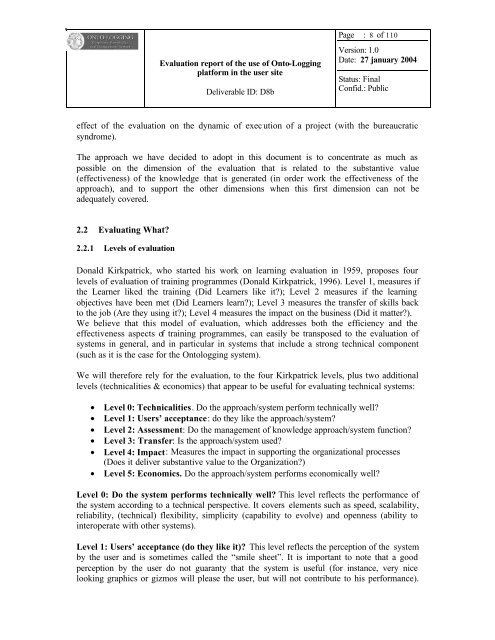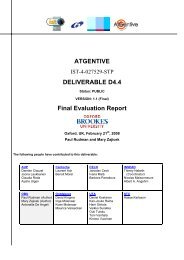pdf 820Kb - INSEAD CALT
pdf 820Kb - INSEAD CALT
pdf 820Kb - INSEAD CALT
Create successful ePaper yourself
Turn your PDF publications into a flip-book with our unique Google optimized e-Paper software.
Evaluation report of the use of Onto-Logging<br />
platform in the user site<br />
Deliverable ID: D8b<br />
Page : 8 of 110<br />
Version: 1.0<br />
Date: 27 january 2004<br />
Status: Final<br />
Confid.: Public<br />
effect of the evaluation on the dynamic of exec ution of a project (with the bureaucratic<br />
syndrome).<br />
The approach we have decided to adopt in this document is to concentrate as much as<br />
possible on the dimension of the evaluation that is related to the substantive value<br />
(effectiveness) of the knowledge that is generated (in order work the effectiveness of the<br />
approach), and to support the other dimensions when this first dimension can not be<br />
adequately covered.<br />
2.2 Evaluating What?<br />
2.2.1 Levels of evaluation<br />
Donald Kirkpatrick, who started his work on learning evaluation in 1959, proposes four<br />
levels of evaluation of training programmes (Donald Kirkpatrick, 1996). Level 1, measures if<br />
the Learner liked the training (Did Learners like it?); Level 2 measures if the learning<br />
objectives have been met (Did Learners learn?); Level 3 measures the transfer of skills back<br />
to the job (Are they using it?); Level 4 measures the impact on the business (Did it matter?).<br />
We believe that this model of evaluation, which addresses both the efficiency and the<br />
effectiveness aspects of training programmes, can easily be transposed to the evaluation of<br />
systems in general, and in particular in systems that include a strong technical component<br />
(such as it is the case for the Ontologging system).<br />
We will therefore rely for the evaluation, to the four Kirkpatrick levels, plus two additional<br />
levels (technicalities & economics) that appear to be useful for evaluating technical systems:<br />
• Level 0: Technicalities. Do the approach/system perform technically well?<br />
• Level 1: Users’ acceptance: do they like the approach/system?<br />
• Level 2: Assessment: Do the management of knowledge approach/system function?<br />
• Level 3: Transfer: Is the approach/system used?<br />
• Level 4: Impact: Measures the impact in supporting the organizational processes<br />
(Does it deliver substantive value to the Organization?)<br />
• Level 5: Economics. Do the approach/system performs economically well?<br />
Level 0: Do the system performs technically well? This level reflects the performance of<br />
the system according to a technical perspective. It covers elements such as speed, scalability,<br />
reliability, (technical) flexibility, simplicity (capability to evolve) and openness (ability to<br />
interoperate with other systems).<br />
Level 1: Users’ acceptance (do they like it)? This level reflects the perception of the system<br />
by the user and is sometimes called the “smile sheet”. It is important to note that a good<br />
perception by the user do not guaranty that the system is useful (for instance, very nice<br />
looking graphics or gizmos will please the user, but will not contribute to his performance).
















